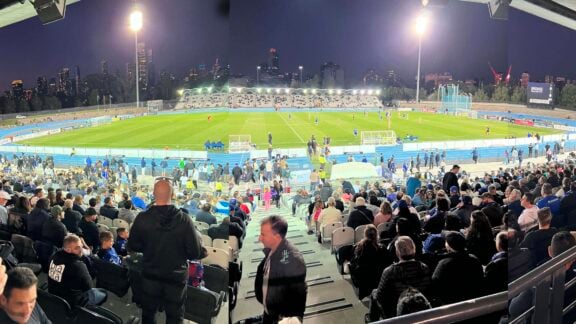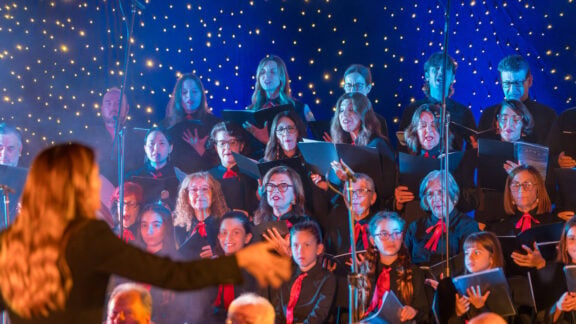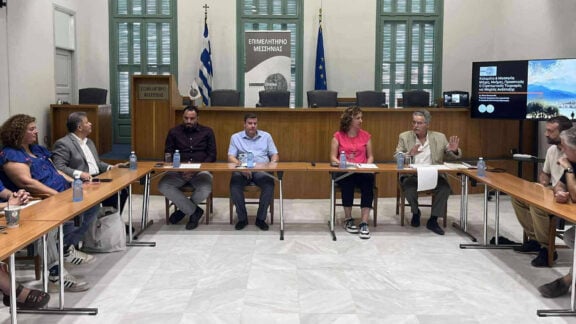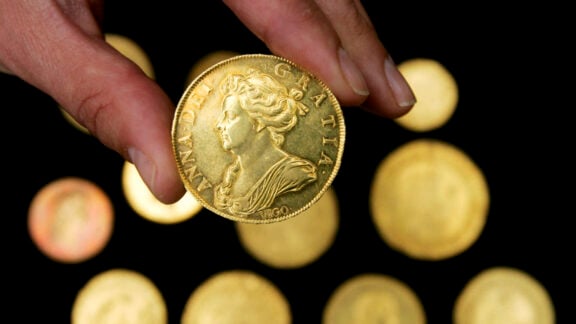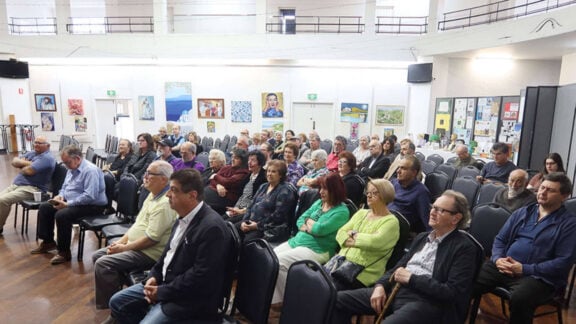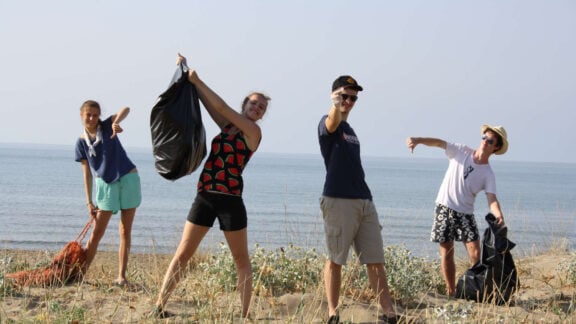Probably the best way to get an insight into an exhibition is to see it multiple times and at least once with the artist who created it. I had seen this show twice before I spent an afternoon with Phillip George to discuss his latest One Minute Mountain, only to find myself engaged in a conversation on his art, but which whirled around and beyond it, encompassing history, physics, metaphysics, philosophy, politics and the lingering effects of war.
One Minute Mountain showcases works by George that explore the ocean as a reflective surface that echoes fractured histories and recurring imagery. This new series marks a departure from the artist’s classical approach, diving into a more fluid and relational spatial perspective. Captured across locations including Bondi, Nazaré, Greece, Alexandria, Persia, and the broader Middle Eastern archipelagos and seascapes, George uses water as a powerful metaphor for the ebb and flow of cultural memory and significance.
In 2003 in reaction to the war in Iraq he disregarded the reports from the Australian press and began his travels throughout the Middle East. Here he found the ancient past rubbing shoulders with the 21th Century, not only in the odd Roman column flanking the entrance to a pock-marked building with its facade full of bullet holes, its foundations rocked by bombs, but also in the thousands-of-years-old values, traditions, alliances, feuds and conflicts that still animate these societies today.
George has been going back ever since, creating a symbolic language out of random discoveries in places as disparate and desperate as a bombed-out POW camp in Lebanon or cities like Al-Fallujah, which have been so poisoned by depleted uranium that they are now bedevilled by high rates of childhood cancer.
All societies, he suggests, can only reach their peak if they are multicultural. Successful ancient cities like Athens and Palmyra were based on their diversity of races and religions, which is why their tiny symbols may include an evil eye, a hamsa, or a koumbaloi near each other, as they were in life.
In his various series such as Trace the Tidal Shift, Drawing in Water, Acheiropoieta Persia, and About the Drowning of Haji Zorzopoulo, all of which are represented here, he has created images filigreed with hidden details that slowly emerge from behind the colour blue or from under the yellow of shifting desert sands. His photographs invite you to linger and take your time because, as he says, “You can’t hit people over the head with ideologies. The work can be decorative but full of political meaning. The more you unpack it, the more you see.”
A book floating to the bottom of the sea, for instance, its pages teased open by the water in some fantastical imitation of a shell, is a Hadith—a record of the words and works of the Prophet Muhammad—that George found in a bombed-out POW camp in Lebanon. Its owner was long gone, but the book speaks of comfort, of devotion, or even perhaps, of radicalisation. Two marble feet, the remnants of a statue of the Emperor Constantine, lie on the ocean bed in juxtaposition with the rusting carcass of a jet bomber. History is meaningful, but it is also messy and incompetent, leaving the detritus of different epochs to share the same fate: leaving issues unresolved from one generation to the next. Although the present is the logical outcome of the past, the past, too, only exists within the context of the present.
At first glance, the photo of Agia Sophia could be the simple movement of sand over dunes until you see the upended icons at the bottom of the canvas, emerging like whispers from the golden haze that hovers over the idea of Byzantium. Here, they are a metaphor for the knowledge that has been discovered, covered, and recovered, according to the historical imperatives of the time.
“You can’t hit people over the head with ideologies. The work can be decorative but full of political meaning. The more you unpack it, the more you see.”
One wall is the exclusive domain of a video of the surf at Nazare, Portugal. A tiny surfer serves as a counterpoint to waves so powerful they could pulverise him at any given moment.
A longtime student of Shaolin, George looks at that mighty swell of water and sees the energy rushing through it to beat itself against the shore, and if he can’t hear the pulse of the planet, he knows its there, referencing his own grueling Shaolin experiences and the theories of Nikolai Tesla who believed that if he could harness that resonance he could split the planet in half.
In the fine detail of his work, George fragments the grand scope of historic events, reducing them to remnants of pottery or slivers of silver, and leaving instead of a vibrant boulevard, the skeleton streets of a submerged city. However, the part represents the whole, and nothing loses its identity: the shard is the pot; that bit of silver is the bracelet, and those streets are the town itself.

History is a human construct, but it is indifferent to humanity. When a ring falls off a doomed finger to lie among the bits of shell and crushed bones of minuscule creatures on the ocean floor, waiting to be transformed by gravity, pressure and time into a glint of gold in newly formed limestone, History makes no distinction between the ring and the finger.
The term Acheiropoieta is a word from religious iconography that means that an artistic work has been achieved without human intervention. To George, the closest thing to this is photography. But, a richer connotation lies behind the word, because for an artistic piece to be considered Acheiropoieta, it has to be as close to perfection as it is possible to be. This exhibition, with its radiant intricacies and lacquered meanings, comes close.
*Kiriaki Orfanos is a regular writer on art and travel and an occasional contributor to Neos Kosmos.

